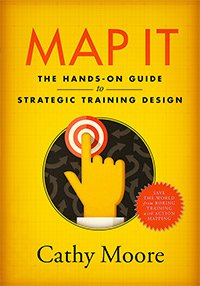Top Elearning Influencers
In an e-learning industry in turmoil, names are emerging and making their mark on the business with innovative and relevant thinking. Even standards are being set!
From Project management, instructional design to content development, here is a list of some influencers and fine minds to follow to learn and stay informed, up to date with best practices of the e-learning industrie.
Top Elearning Influencers
1. Cathy Moore - Map it
Cathy is a world-renowned training innovator dedicated to saving the planet from dull instruction.
She believes that respecting and deeply challenging people is important for business performance.
Her main goals are :
How can have resolve issues
Create engaging activities VS passive courses
Cathy's designs have been utilised by corporations including Microsoft, Pfizer, the US Army, Barclays, and the US Department of the Interior.
She is the designer of the action mapping technique of training design, which has been used by firms around the world to boost performance.
She has been invited to present her ideas for improving instructional design in various countries, as well as being a highly sought-after webinar presenter. Catherine has also won awards for her writing and design, as well as being a design competition jury member.
She has more than 15,000 international subscribers on her blog.
Her ideas are shared by her globally.
Book:
Identify the issue
Fix the goals
Create activities (key concept)
Select the format
Creare engaging challenges
Show the result
Map It Cathy Moore
2. Tim Slade - The eLearning Designer’s Handbook
In The eLearning Designer’s Handbook, Tim Slade will demonstrate that the eLearning development process isn’t as complicated as it might appear.
You’ll receive practical guidance and pointers from Tim as you accomplish the entire eLearning design and development process, whether you’re a novice or professional in the field.
Chapters:
Why Most eLearning Fails
What is eLearning?
How People Learn
Plan the Project
Design a Learning Solution
Draft a Storyboard
Develop the Course
Incorporate Interactivity
Increase Learning Retention
Launch & Measure Your Course
https://elearningacademy.io/books/the-elearning-designers-handbook/
Tim Slade - The eLearning Designer’s Handbook
3. Michael Allen - Guide to e-Learning
Michael Allen's Guide to e-Learning: Building Interactive, Fun, and Effective Learning Programs for Any Company - Second Edition provides practical knowledge on how to develop interactive, fun, and effective online learning programs.
This excellent tome provides the answers to the questions of motivation and interactivity, as well as history lessons to assist you in avoiding common pitfalls and on the right path to e-learning success. It also includes pointers on avoiding common pitfalls and guiding your e-learning efforts.
This book offers multiple perspectives on what makes excellent e-learning, in addition to history lessons that can help you avoid common pitfalls and steer towards success.
In addition, the book considers changes in technology and tools that make it possible to implement the strategies, guidelines, and techniques it covers.
https://www.alleninteractions.com/resources/book/michaels-guide-to-elearning
Book:
How technologie can Help
Create content
Discuss experiences and case studies
Understand key concept
Michael Allen - Guide to e-Learning
4. Devlin Peck Helps Instructional Designers to up skill!
Devlin is a hard worker and dedicated e-learning instructional designer that share to his community tonnes of valuable information.
His YouTube channel regularly publish instructive material to up skill your knowledge and develop knowledge.
Clark Quinn is Quinnovation
Clark Quinn, Ph.D., is known for his learning technology expertise, which enables businesses to meet learning, knowledge, and performance demands through information systems.
His learning experience design combines what we know about how people think and learn with an understanding of technology capabilities to satisfy genuine requirements.
Quinn draws on a range of cognitive science abilities, a wide range of computer and network abilities that has been demonstrated through real-world use, substantial management experience, and a record of successful thinking and innovation.
https://quinnovation.com/About.html
The need for instructional designers to be knowledgeable about learning science is obvious.
We know that learning science is applied to instruction. Knowing how learning works and what helps and hinders it enables us to create effective learning experiences. We must continue to track the latest research and describe how our designs reflect it. Without being scrutable, how can we claim to be competent in our methodology?





